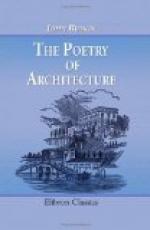[Illustration: Fig. 11. Broken Curves.]
144. Let us take then the simple form a b c d, interrupting the curve c e [fig. 11, A]. Now, the eye will always continue the principal lines of such an object for itself, until they cut the main curve; that is, it will carry on a b to e, and the total effect of the interruption will be that of the form c d e. Had the line b d been nearer to a c, the effect would have been just the same. Now, every curve may be considered as composed of an infinite number of lines at right angles to each other, as m n is made up of o p, p q, etc., (fig. B), whose ratio to each other varies with the direction of the curve. Then, if the right lines which form the curve at c (fig. A) be increased, we have the figure c d e, that is, the apparent interruption of the curve is an increased part of the curve itself. To the mathematical reader we can explain our meaning more clearly, by pointing out that, taking c for our origin, we have a c, a e, for the co-ordinates of e, and that, therefore, their ratio is the equation to the curve. Whence it appears, that, when any curve is broken in upon by a building composed of simple vertical and horizontal lines, the eye is furnished, by the interruption, with the equation to that part of the curve which is interrupted. If, instead of square forms, we take obliquity, as r s t (fig. C), we have one line, s t, an absolute break, and the other r s, in false proportion. If we take another curve, we have an infinite number of lines, only two of which are where they ought to be. And this is the true reason for the constant introduction of features which appear to be somewhat formal, into the most perfect imaginations of the old masters, and the true cause of the extreme beauty of the groups formed by Italian villages in general.




